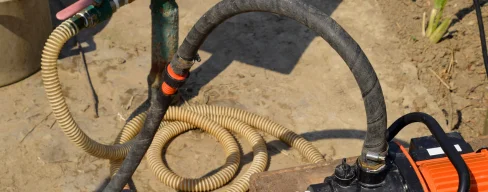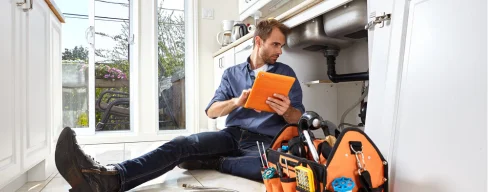Some things might cause a pipe to leak at the connecting point under a sink. A primary factor contributing to this issue is gradual deterioration due to regular use. The constant flow of water, soap, and other debris can cause the connection to weaken and eventually break. Another reason could be improper installation or incorrect use of sealant during installation.
It is essential to hire a professional plumber who has the necessary expertise and knowledge to install the drain pipe correctly and prevent situations when kitchen sink drain pipe leaks at the connection.
Understanding the Anatomy of the Kitchen Sink Drain System and Leaky Pipe Connections
The integrity of these connection points is paramount to maintaining a leak-free system. Here’s a breakdown of the basic components:
Sink Drain: This is the opening where water and waste enter the system from the sink. It typically includes a strainer to prevent large debris from going down the drain.
P-Trap: This curved section of pipe is designed to trap a small amount of water after each sink use, forming a seal to prevent sewer gases from entering the home.
Waste Arm: This is a horizontal pipe that connects the P-trap to the waste line. It allows water and waste to flow from the P-trap into the larger waste system.
Waste Line: This is the main pipe that leads to the sewer system or septic tank. It’s tasked with the transportation of wastewater out of the home.
Each of these components connect to form the complete kitchen sink drain system. A common issue homeowners face is a pipe under sink leaking at connection points, such as where the P-trap meets the waste arm, or where the waste arm connects to the waste line.
Such leaks can stem from improper installation, damaged seals, or pipe corrosion. It’s important to regularly check these connection points and address any signs of a kitchen sink drain pipe leaking at connection without delay.
This not only prevents water damage, but also ensures the system functions efficiently, maintaining the health of your kitchen plumbing.
Culprit 1 – Loose or Improperly Fitted Connections
Loose or improperly fitted connections often stand as one of the primary causes of a kitchen sink drain pipe leaking at connection. If the connections are not tight enough or if they are not correctly configured, it can lead to a poor seal, resulting in a steady drip or even a steady stream of water leaking from the connection point.
How to Properly Secure and Tighten Connections:
Turn Off the Water: Before you start working on tightening the connections, ensure that the water supply to the sink is turned off to prevent any unnecessary water flow.
Locate the Loose Connection: Inspect the connections between the sink drain, P-trap, waste arm, and waste line. The loose connection could be at any of these points. Wiggle each one gently to see which is loose.
Tighten the Connection: Use a pipe wrench or a pair of channel lock pliers to grip the loose connection. Turn it clockwise to tighten it. Be careful not to over-tighten as this could damage the threads.
Check for Leaks: Once you’ve tightened the connection, turn the water supply back on and run water down the sink drain to check for leaks. If there are no leaks, then the problem has been fixed. If the connection is still leaking, it may be improperly fitted or require a new seal or gasket.
By ensuring that all the connections in your kitchen sink drain system are correctly fitted and tightened, you can effectively prevent leaks and maintain the health of your kitchen plumbing.
Culprit 2 – Corrosion and Rust of Drain pipes
Another common cause of a kitchen sink drain pipe leaking at connection is corrosion and rust. The continuous exposure of metal pipes to moisture and oxygen makes them susceptible to corrosion, which is a natural process that gradually degrades the material.
Rust is often visible as a reddish or yellowish-brown flaky coating on the metal surface. This is a clear sign that the pipe or connection is deteriorating, which can lead to a compromised seal and eventually to leaks.
The manifestation of rust is not only a sign of a potential leak but also of a pipe that is reaching the end of its useful life and might need replacing.
Regular inspections of the kitchen sink drain system can help detect the early stages of corrosion and rust. Look for discoloration, flaking, or pitting on the pipe surface.
If caught early, small patches of rust can be cleaned and treated with rust inhibitors to slow down the corrosion process. However, more severe rust or corrosion often requires the replacement of the affected part.
Implementing preventive measures can also significantly prolong the lifespan of your kitchen sink drain system components and minimize corrosion. Using pipes made from rust-resistant materials like PVC or brass can be a great deterrent.
Remember, when dealing with a kitchen sink drain pipe leaking at connection, addressing the issue promptly can save you from a lot of hassle and expenditure in the long run. So, keep an eye out for corrosion and rust, among other factors, and ensure your sink drain system remains in good health.
Culprit 3 – Aging and Wear
Natural wear and tear over time is a common factor contributing to the problem of a kitchen sink drain pipe leaking at connection. Much like any other components in your home, your kitchen sink drain system isn’t immune to the inevitability of time and usage. With years of constant exposure to water, food particles, cleaning agents, and temperature fluctuations, the pipes and connections can gradually degrade, lose their structural integrity, and eventually a kitchen sink drain pipe leaking at connection.
The gaskets and seals that ensure a watertight connection at various points in the drain system are particularly susceptible to wear and tear. Over time, they may lose their elasticity and fail to form a tight seal, allowing the kitchen sink drain pipe leaking at connection. The deterioration of these components might be hard to notice until a leak occurs, highlighting the importance of regular inspections.
Regular Inspections and Replacement of Worn-Out Components
To mitigate the risk of leaks due to aging and wear, proactive monitoring of your kitchen sink drain system is crucial. Regular inspections help to identify any signs of wear or aging in the components of the drain system, such as cracking, warping, or loss of sealing.
- Check the Seals and Gaskets: Visually inspect the seals and gaskets at the connection points for any signs of cracking or hardening. A seal that is losing its flexibility or showing visible cracks needs to be replaced.
- Inspect the Pipes: Look for any signs of warping or deformation in the pipes. If the pipes appear to be out of shape or overly worn, it might be time to replace them.
- Replace Worn-Out Parts: If an inspection reveals any worn-out parts, replace them promptly. Delaying this can only lead to more severe issues down the line, such as leaks or even water damage.
By taking steps to regularly inspect and replace worn-out components, you can significantly reduce the risk of a kitchen sink drain pipe leaking at connection due to aging and wear. Remember, prevention is always better — and cheaper — than cure.
Culprit 4 – Blockages and Clogs
Blockages and clogs are another significant reason behind a pipe under sink leaking at connection. When the flow of water is obstructed due to solidified grease, food particles, hair, or any other kind of debris, it can lead to a buildup of pressure in the pipes. This excessive pressure can strain the connections, resulting in leaks.
If you discover a blockage, it’s important to address it promptly. For minor clogs, a plunger can often do the trick. A mixture of vinegar and baking soda followed by hot water can also help dislodge blockages, while being gentle on your pipes. For more stubborn clogs, a plumber’s snake or hand auger can be used to reach deeper into the pipe and break up the blockage.
In case of severe blockages, or if you are uncomfortable handling the task, don’t hesitate to seek professional help. The cost of dealing with a clog is insignificant compared to the potential damage that could result from a pipe under sink leaking at connection.
Remember, preventing and promptly addressing blockages can go a long way in maintaining the health drain system and preventing leaks.
When to Seek Professional Help
Often, despite our best efforts and preventative measures, a pipe under sink leaking at connection can present complicated situations that require the expertise of a professional plumber.
One such instance is when you’ve attempted to replace a damaged pipe or seal, and the leakage persists. The continued leak might be an indication of an underlying, more complex issue that needs to be addressed by a seasoned professional.
Moreover, if you notice a sudden and significant increase in your water bill, it could be due to a leak that’s not easily visible or accessible. This is another scenario where professional help should be sought.
Plumbers have specialized tools and equipment that allow them to detect and locate pipe under sink leaking at connection, even this is hidden from plain sight.
Additionally, if you have a recurrent issue of clogs and blockages that persist despite regular cleaning and mindful usage, it might point to a structural problem in your plumbing system. A professional plumber can accurately diagnose such problems and provide effective solutions.
Remember, while minor maintenance and preventative measures can be handled on your own, complex issues demand professional intervention. The cost of hiring a professional plumber for a pipe under sink leaking at connection is an investment towards the long-term health of your plumbing system.
It can save you a significant amount of money in the long run by avoiding extensive water harm and the need for complete plumbing system overhauls.
In conclusion, there are several potential culprits behind a pipe under sink leaking at connection, including aging and wear of the pipe and its components, blockages, and clogs. Regular inspections, replacement of worn-out components, and mindful usage of the sink are crucial steps in preventing these issues.
However, in the face of persistent or more complex issues, it’s wise to seek the expertise of a professional plumber. Remember, a pipe under sink leaking at connection isn’t just a small inconvenience—it can lead to significant water damage and inflated bills if left unattended.
Professionalism at DrainExpress
At DrainExpress, professionalism is at the core of who we are and what we do. Our team is composed of licensed and experienced plumbers, each one dedicated to providing exceptional service.
We believe in the importance of punctuality, respecting our customers’ time and ensuring that we arrive and complete our work within the stipulated time frame.
Simultaneously, we understand that plumbing issues can cause significant inconvenience and stress, so we strive to communicate clearly and effectively, maintaining transparency in our services and charges.
Our professionalism also extends to the quality of our work. We use only the highest quality materials and current industry best practices to ensure our work’s longevity and safety. We stand behind our work and offer guarantees on our services for the ultimate peace of mind for our customers.
At DrainExpress, we are more than just a plumbing company – we are a team committed to providing reliable, professional service to solve our clients’ plumbing needs.
Contact Details
Email: info@drainexpress.ca
Phone:
+1 416 752 5959
Our Location
300 New Toronto St #14,
Etobicoke, ON, M8V 2E8
24/h Customer Service
We are open 24/7
Contact us at any time

